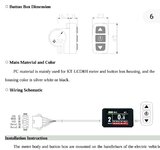I would love to replace my OEM Dapu controller with a KT that has a better display,
I loved my KT controller/display until I got my Voltbike.
I've not riden my Et.Cycle T1000 (that has the KT installed) since I started riding my Voltbike, and I only rode my Voltbike once when it arrived then parked it for three months because I was too lazy to learn how to work it.

BUT !!!
The KT Display has the same standard Green/5 pin/Julet connector as my Voltbike, so I intend to swap displays and see what happens.
The KT display schematic is just about as hopeless as trying to memorize the meanings of all these parameters, ..
but fooling around with the motor phase wires and 9 pin motor connector is above my pay grade right now.
I managed to do all that with my Das-Kit motor to install my KT, so I'm not worried about that part, but I don't want to plug either display into either controller until I verify the pin-out diagram.
I can't find the pinout for the motor cable so it would be trial & error with the possibility of damage.
I'm pretty sure it's your standard motor cable connector just like my Das-Kit (re-branded MXUS) motor, but I'm not going to do something stupid until I can 'Sit Down and Think about what I've Done !!!'.

So I'll wait until this winter before I start poking and prodding.
I also don't want to loose the way that the throttle and PAS interact on the Dapu.
Yeah, I know what you mean, even though I don't pedal.
The Voltbike accelerates at it's pre-programmed acceleration power curve but I can over-ride it by giving it more or less throttle.
It pulls harder while accelerating when I give it more throttle.
BUT,..
I'm not sure if I'm actually getting "Full" power or not?
My Et.Cycle seems to pull harder and the Voltbike current/power meter is a dummy gauge like the one on my old piece of crap e-bike, and the temperature gauge on my car, where they are controlled by the computer.
I did however, turn my Voltbike down to 16 amps, so that could be why it feels so gutless.
I don't take notes and tend to forget A LOT of stuff.
Something to do with my short term memory or something.
I dunno, I kinda forget.
Maybe it's my home-grown medicine.??


⚕





